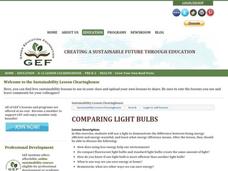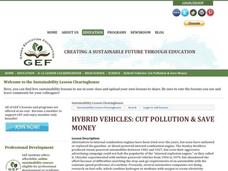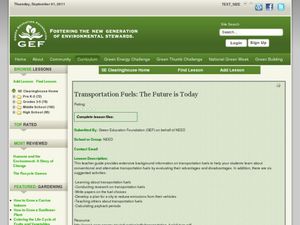Curated OER
So Much Water, So Little to Drink
Students explore salt and fresh water. In this water lesson, students investigate the amount of Earth covered by water. Students compare the amounts of salt water to fresh water. Students create a visual representation to aid comprehension.
Curated OER
Drip and Drop's Adventure
Students determine ways of conserving water and write a Big Book about them. In this water conservation lesson, students participate in a puppet show about Drip and Drop, and ways to conserve water. They write a book that tells about...
Curated OER
Conserving Water through Art!
Learners study water conservation. In this water conservation activity, students investigate the scarcity of water and determine reasons for conserving water. Learners estimate how much water they use in one day and identify ways...
Curated OER
Be "Sun-sible" about Heating Water
Learners create a solar water heater. In this solar energy lesson, students conduct an experiment to determine which colors absorb more radiant heat. Learners investigate the relationship of heat loss to insulation. Students then create...
Curated OER
Snack Smart!
Students discover healthy snacks. In this healthy snacks lesson, students create a healthy snack. Students sample a simple healthy snack.
Curated OER
Where Is Away?
Students explore garbage. In this landfill lesson plan, students investigate how much garbage is collected in landfills on average each day. Students discover hazardous materials that are disposed of improperly and the effects of these...
Curated OER
Comparing Light Bulbs
Third graders learn how light bulbs are different and which are more cost efficient. In this energy and efficiency instructional activity, 3rd graders compare the cost of a light bulb and understand that its lifetime is important...
Curated OER
Hazardous Products Substitutes
Third graders write a hazardous products substitutes recipe book. In this Science lesson plan, 3rd graders identify words and symbols that indicate hazardous substances. Students investigate safe substitutes and write a recipe book to...
Curated OER
Draft-O-Meter
Students explore where there are drafts in their homes. In this waste reduction lesson, students experiment with a students made draft-o-meter and record drafts on a worksheet.
Curated OER
Hot and Cold Colors
Students experiment with the color and solar energy absorption. In this color and solar energy absorption lesson, students spend two days discussing and experimenting with the concept of energy absorption. They paint cans with different...
Curated OER
Energy Transfer (Heat)
The pages of this resource are in landscape view and ready-made to use as slides in a presentation on energy transfer in your high school physical science course. Begin with pertinent vocabulary and finish with an explanation of the...
Curated OER
Water Meter Reader
Junior high schoolers learn how to read a water meter, track their family water usage, and discuss the amount in class with other pupils. They will interpret real-world data and graph it. It is ideal for increasing awareness and...
Curated OER
Be Water Wise!
Rally your administration and facilities manager to let your class examine the water flow rates in different areas of the school. After the audit, the class researches opportunites for conserving water and writes a report or develops a...
Curated OER
Mission Possible: Energy Trade-offs
Teams of electrical engineers work together to develop plans for increasing electricity to a fictitious, but growing community. They consider different sources of electricity, both renewable and nonrenewable, the cost of building and...
Curated OER
The Math of Renewable Energy
Students research additional information about questions on their worksheet. In this energy activity, students develop visual aids of their proposed solution to the problem. They present their work in class.
Curated OER
A Matter of Accountability
Pupils conduct a mock trial focusing on environmental accountability of industrialized nations. As an example, they evaluate evidence provided on carbon dioxide emissions. They participate in a mock trial of industrialized nations by the...
Curated OER
Transportation Fuels Debate
Students study the different transportation fuels. In this energy sources lesson students debate the merits of their fuel over others while working together in groups.
Curated OER
The Biofuel Project: Creating Biodiesel
Students research about the processing of biodiesel fuels. In this energy lesson, students produce their own biodiesel using used and new vegetable oil. They discuss the environmental and economic benefits of using biodiesel.
Curated OER
Hybrid Vehicles: Cut Pollution and Save Money
Math and science meet in this lesson on hybrid electric automobiles. This 24-page resource provides everything you need for teaching a lesson that compares the use of internal combustion engines to hybrid electric engines. Participants...
Curated OER
Transportation Fuels: The Future is Today
Assign each group of 3-4 upper elementary engineers to a different type of transportation fuel. A background information page is provided to get them started with researching their assigned fuel. Each group then produces an exhibit...
Curated OER
Survival Still
Lead your class to construct a solar still on campus to demonstrate how water can be extracted from the soil. The power of solar energy is emphasized, as is the concept of how capillary water can be recovered and purified by using a...
Media Smarts
Looking at Newspapers: Introduction
A scavenger hunt introduces class groups to the different sections of newspapers and the different types of articles found in each section.
Curated OER
Effects of Oil Spills on Environment and Marine Life
Students explore oceanography by conducting an environmental experiment in class. In this oil spill instructional activity, students discuss the human need for oil and what is at stake when we drill for oil in our oceans. Students read a...
Curated OER
Make and Shake a Snowglobe
Young scholars make a holiday or seasonal snow globe to give as a gift. Make it, then shake it! Students use small jars with lids. They use a glue gun or silicon glue to attach a small plastic toy to the inside of the lid. When the glue...























